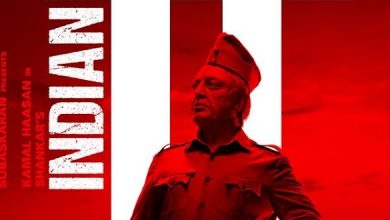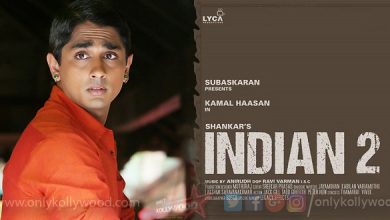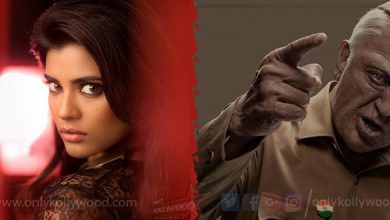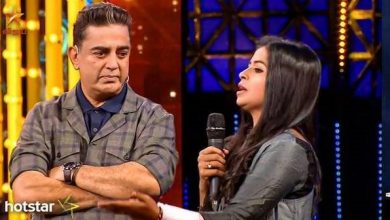Interview with Ramesh Aravind – the director of Uttama Villain
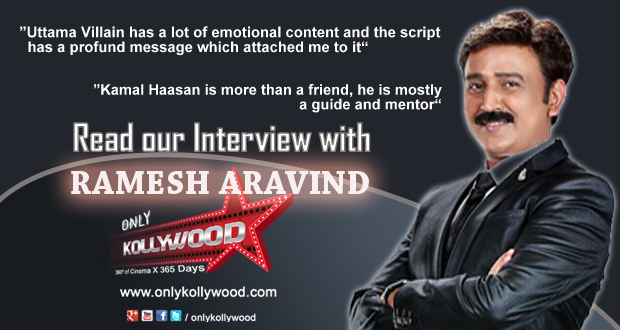
Few minutes with actor-filmmaker Ramesh Aravind is all you need to know that he enjoys breaking into a conversation even with a stranger he’s just met. Ramesh Aravind is an interviewer’s delight, whether he is talking about cinema, Kamal Haasan or life in general. As we settle down for a chat with him on a serene morning at a restaurant in Chennai, he asks enthusiastically, if it’s fine he speaks in English as well as Tamil through the course of the interview. We nod in agreement and request him to take us back to his heyday in cinema.
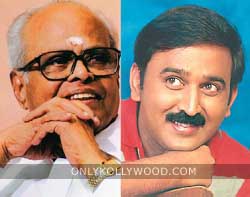 First meeting with K. Balachander
First meeting with K. Balachander
From Manadhil Uruthi Vendum to Uttama Villain, Ramesh Aravind has come a long way. He has donned various hats including actor, director, screenwriter and TV host. “KB sir was on the lookout for someone to play Kamal Haasan’s part in the Kannada version of Sollathaan Ninaikkiren. He had cast all the other actors except the role essayed by Kamal. Somebody had informed him about me and I was doing television at that time in Bangalore. KB sir wanted to meet me and I came down and met him in his office in Chennai. We spoke for about an hour and during the course of the interaction, he constantly kept looking at my eyes. By the time we finished talking, he asked me to get my dates for shooting. That was the first meeting and the film was Sundara Swapnagalu, Ramesh reminsces his first encounter with K. Balachander.
Manadhil Uruthi Vendum is actually Ramesh Aravind’s second film. “Initially, I was never supposed to be part of the film. I was signed on to do a Bhagyaraj film. Since I had only a brief role in Manathil Uruthi Vendum, KB sir insisted that I work with Bhagyaraj but unfortunately that film got shelved for reasons unknown. Then, I went back to KB sir and he signed me on for Manadhil Uruthi Vendum. I had no idea who was originally decided to be cast in my role. But that’s how that film happened.”
Ramesh Aravind had the luxury of being introduced by K. Balachander in Tamil, Telugu and Kannada. “KB sir introduced me in Telugu with Rudra Veena, which was later remade as Unnal Mudiyum Thambi. In all the three languages, I had the honour of being officially introduced by Balachander. Although I had done a Kannada film called Mouna Geethe even before my Kannada debut, it released only after Sundara Swapnagalu,” Ramesh recalls intricately.
Enviable filmography in Tamil
Though we don’t get to see Ramesh Aravind frequently in Tamil cinema these days, he has an enviable filmography in Tamil with a variety of films such as Duet, Rhythm, Panchathanthiram, Jodi to name a few. “After the success of Vasanth’s Keladi Kanmani, I would’ve signed about ten films in Tamil. I shifted base to Chennai. I stayed here for the next six years and worked in about 40 films (Tamil as well as Kannada). After Duet and Sathi Leelavathi, nine of my films in Kannada consecutively turned out to be blockbusters. F ollowing the overwhelming success, I was forced to go back to Bangalore. I became extremely busy with multiple projects and I couldn’t find time to juggle between the industries. A lot of people asked me why I disappeared from Tamil industry, but the truth was that I had my hands full
ollowing the overwhelming success, I was forced to go back to Bangalore. I became extremely busy with multiple projects and I couldn’t find time to juggle between the industries. A lot of people asked me why I disappeared from Tamil industry, but the truth was that I had my hands full
with Kannada films,” Ramesh tells us.
“As years went by, people assumed that I’m more interested in working in Kannada, so naturally, offers in Tamil dried up. But I kept working with Kamal sir in his films out of friendship. But after Uttama Villain, I’ve decided to work in Tamil films, act as well as direct, frequently.”
Ramesh Aravind has worked some brilliant filmmakers in Tamil including K. Balachander, Vasanth, Balu Mahendra, K.S Ravikumar, Visu and Singeetham Srinivas Rao. And, he has learnt something from everyone he has worked under. “I think all these filmmakers were extremely good. They had different styles and that’s what made them so unique and different from one another. For example, Balachander is someone who always likes to see something interesting from his actors. It could be even throwing a cigarette, but he wants it to be done interestingly. Balu Mahendra insists on being natural. He wouldn’t allow his actors to do something crazy. When I make films, I try to be Balachander as well as Balu Mahendra,” says Ramesh.
 Directorial debut and the best compliment from Sujatha Rangarajan
Directorial debut and the best compliment from Sujatha Rangarajan
Ramesh Aravind made his directorial debut in Kannada by remaking Balu Mahendra’s cult classic Sathi Leelavathi – in which he played an important role – as Rama Shama Bhama. “It’s one of my favorite films. When I decided to wield the megaphone, I wanted to remake Sathi Leelavathi from a modern-day perspective. The remake came out extremely well.”
But, the most cherished compliment for Ramesh came from late writer Sujatha Rangarajan. “I remember watching the special premiere of the movie with Sujatha sir and Balu Mahendra sir. I was seated on Sujatha’s right, while Balu sir sat on his left. When the film got over, Sujatha wondered looking at us how we could (Balu sir and I) make the same film so differently. It was a very satisfying compliment because the remake was not a carbon copy of the original. In fact, in the remake, Kamal sir comes way too early compared to the original. We made these small changes and it worked so well in the favour of the film. But it was the brains of Kamal sir, Balu sir and Crazy Mohan that helped Rama Shama Bhama become a big hit,” Ramesh tell us.
Bonding with Kamal Haasan
Ramesh Aravind and Kamal Haasan share a special bond. Whenever you see the former disappear from Tamil films, you can be assured that he will make a comeback soon through a Kamal Haasan film. “I learnt a lot of from Kamal sir from a very young age. I’ve been his biggest fan. I grew up on Kamal as well Rajini films. Both Kamal and Rajini were at the pinnacle of their career when I was growing up as a teenager. I would sincerely adore them and watch their films with some level of craze. Growing up on their films and later working alongside Kamal sir on several occasions helped us bond as co-stars and eventually as friends.”
I grew up on Kamal as well Rajini films. Both Kamal and Rajini were at the pinnacle of their career when I was growing up as a teenager. I would sincerely adore them and watch their films with some level of craze. Growing up on their films and later working alongside Kamal sir on several occasions helped us bond as co-stars and eventually as friends.”
“Kamal Haasan is more than a friend, he was mostly a guide and mentor,” says Ramesh. “But come to think of it, it was not cinema on which Kamal sir and I bonded. We bonded because we share the same sensibilities on various things in life. It’s easier to build relationship with a person when you share same ideologies and tastes.”
Ramesh reveals that he seldom discusses cinema with Kamal Haasan whenever they meet. Their discussions were always about ideas and creative collaboration. “We would discuss about books we read or an interesting article that we came across. We would always have fun and unwind amidst all this, but it was mostly about ideating together. Both of us would be always be curious about things we came across. I think it was these things that brought us closer,” says Ramesh.
Origin of Uttama Villain
Ramesh Aravind had plans to collaborate with Kamal Haasan soon after Rama Shama Bhama for a Hindi film, but it never materialized. “We also wanted to work on another Tamil film. I was also busy with my own career in Karnataka. I act, write or host a TV show, I keep on
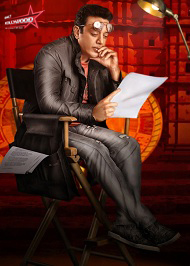 doing some work. All these years, our idea to collaborate never really happened. Last March, Kamal sir asked me to direct this script. I thought it was a fantastic idea. Once he told me, I stopped doing whatever I was doing in Kannada; otherwise my hands are mostly full. I wanted to concentrate on this project because I felt I needed a big leap in my career at this point,” Ramesh tells us.
doing some work. All these years, our idea to collaborate never really happened. Last March, Kamal sir asked me to direct this script. I thought it was a fantastic idea. Once he told me, I stopped doing whatever I was doing in Kannada; otherwise my hands are mostly full. I wanted to concentrate on this project because I felt I needed a big leap in my career at this point,” Ramesh tells us.
“Initially, we started working on an idea. After few months, we ditched that idea and embarked on another one. It was bound to change because we were brainstorming throughout. After few months, we decided we’ll work on a story that eventually became Uttama Villain. It’s extremely different from Vishwaroopam, and it has a lot of emotional content. The best part about the script is that it has a very profound message which attracted me to it,” reveals Ramesh Aravind.
On directing the triumvirate of Kamal Haasan, K. Balachander and K. Vishwanath
Ramesh Aravind considers himself lucky to direct this triumvirate of Kamal Haasan, K. Balachander and K. Vishwanath in one film. “It was Kamal sir’s idea to cast KB sir and Vishwanath sir. I’m a huge fan of all three of them and to have them work in the same film was a fantastic idea,” he says. In Uttama Villain, K. Balachander essays the role of a mentor to Kamal Haasan, who plays an ageing cine star in the film’s 21st century portions. ”Kamal sir was very keen that we should only cast Balachander for the role because he felt only he could naturally fit in it and do justice to it. When you watch the film, you realize nobody else 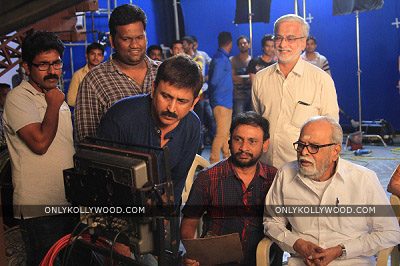 could do the role besides KB sir. Had we cast someone else, then we would have had to include a few more scenes to establish the master-disciple relationship. We wanted to avoid all that because there certain advantages and liberty when you cast certain people,” justifies Ramesh the idea behind casting K. Balachander.
could do the role besides KB sir. Had we cast someone else, then we would have had to include a few more scenes to establish the master-disciple relationship. We wanted to avoid all that because there certain advantages and liberty when you cast certain people,” justifies Ramesh the idea behind casting K. Balachander.
Ramesh never felt sort of pressure directing his mentor, thanks to his good relationship with Iyakunar Sigaram. “I thoroughly enjoyed directing because I had nothing else to worry about. I had a very supportive crew and since KB sir was required to be himself on screen, there was hardly any work involved in directing. I would happily sit back in my chair when a shot was over and start afresh when it was time to shoot a new scene. Moreover, since I was working with seasoned actors, there was absolutely no need to tell them what to do and what not. With KB sir, it’s always a pleasure to work because there’s so much you can still learn from him,” says Ramesh.
Theyyam – A thousand year old traditional art form
 A little googling will tell you that Kamal Haasan plays an 8th century drama actor in Uttama Villain – as one of the roles – who practices Theyyam, a traditional art form originated in Kerala thousand years back. “It was once again Kamal’s idea to dabble with the traditional art form. When he initially showed me how he would use it in the story, I was totally zapped,“ Ramesh tells us. He also brushes aside reports that they have copied the art form. ”I want to set the record straight because we’ve only been inspired by it and have used it with certain creative liberties. Initially, when Kamal sir had suggested Theyyam, we all sat down and learnt about it individually and then collectively brainstormed about how we could use it in our story. Finally, when we zeroed in on an idea we had developed based on the traditional art form, we decided to include it in the film.”
A little googling will tell you that Kamal Haasan plays an 8th century drama actor in Uttama Villain – as one of the roles – who practices Theyyam, a traditional art form originated in Kerala thousand years back. “It was once again Kamal’s idea to dabble with the traditional art form. When he initially showed me how he would use it in the story, I was totally zapped,“ Ramesh tells us. He also brushes aside reports that they have copied the art form. ”I want to set the record straight because we’ve only been inspired by it and have used it with certain creative liberties. Initially, when Kamal sir had suggested Theyyam, we all sat down and learnt about it individually and then collectively brainstormed about how we could use it in our story. Finally, when we zeroed in on an idea we had developed based on the traditional art form, we decided to include it in the film.”
Kamal Haasan’s strenuous make-up for Uttama Villain
That Kamal Haasan has a penchant for sporting different looks is a long-known fact and so are his exhaustive make-up sessions for his films. And, it continues in Uttama Villain too. “Kamal sir spent a lot of time to get into the skin of the 8th century character. He patiently sat for four hours the first time he got the makeup on his face for the first motion poster of the film. He had designed the look of the character and he ensured that he got it right every time he sat down in the makeup room,” raves Ramesh about Kamal Haasan’s commitment towards every minute detail in the film.
We wanted to seize this moment and threw a tricky question at him – Who do you like the most, Kamal Haasan the actor or the  writer? “It’s tough to choose but I personally enjoy watching the actor Kamal come alive on screen. I don’t think there’s nothing more satisfying than watching Kamal act. This I say as his biggest fan, co-actor and friend. When I don the hat of a writer, I look at Kamal Haasan as the writer for inspiration, but I really enjoy watching Kamal sir act. Maybe when you ask him, he would say he may like doing so many other things but his stardom is for the actor in him. What I’ve realized after knowing Kamal sir for so many years is that we can’t just restrict him to acting and writing. There’s so much more to him. There’s Kamal the director, composer and even choreographer. So, it’s really tough to choose from his multi-faceted personalities.”
writer? “It’s tough to choose but I personally enjoy watching the actor Kamal come alive on screen. I don’t think there’s nothing more satisfying than watching Kamal act. This I say as his biggest fan, co-actor and friend. When I don the hat of a writer, I look at Kamal Haasan as the writer for inspiration, but I really enjoy watching Kamal sir act. Maybe when you ask him, he would say he may like doing so many other things but his stardom is for the actor in him. What I’ve realized after knowing Kamal sir for so many years is that we can’t just restrict him to acting and writing. There’s so much more to him. There’s Kamal the director, composer and even choreographer. So, it’s really tough to choose from his multi-faceted personalities.”
Uttama Villain features a bevy of young artists like Parvathi Menon, Andrea, Pooja Kumar, and also a bunch of seasoned performers like Urvashi, Nassar, M.S. Bhaskar and Jayaram. But Ramesh Aravind never had any trouble handling them. “It was fun working with the youngsters. They come with a lot of passion towards cinema, if not years of experience like other seasoned actors of the crew. In fact, we conducted rehearsals for every scene in advance. Even Kamal sir attended all rehearsals sessions and it naturally made everyone else in the crew to follow suit. When Kamal sir is going out of his way to act out a scene perfectly, these youngsters automatically get motivated in the process to do it. He set the example. It was like watching students learn acting in a drama school.“
 Ramesh Aravind – the actor, director and writer
Ramesh Aravind – the actor, director and writer
Having donned many hats such as actor, director and writer, Ramesh Aravind feels there’s nothing more rewarding than an actor’s job. “It might not be in terms of the monetary benefits, but even generally the success you enjoy as an actor is bigger than anything else. I like the success part of being an actor. I don’t think anything can replace the success you derive out of being an actor.”
On the other hand, Ramesh Aravind feels there’s nothing more satisfying than a director’s job and he explains his reasons eloquently for us. “Direction is a creative process. It gives wings to your creativity. It allows you to create a world you might not envision as an actor. As a director, you can make a flower look different on screen, add the color you like the most to your creation and nobody will ask you questions. If you like to get creatively high, you should don the hat of a director. There’s nothing more satisfying than a director’s job if you want to be creative. I direct because I would like to awaken the dormant creative side in me.”
Ramesh Aravind feels writing as a very lonely job and one needs patience like Kamal Haasan to be a great writer. “He’s extremely patient when it comes to writing even a short mail. You think you may not require an email for this particular job, but Kamal sir wouldn’t agree. He would sit down and write everything down. I envy his commitment at times because I don’t have the patience,” Ramesh tells us.
Writers in Indian cinema
Ramesh Aravind agrees that writers are underpaid in Indian cinema. “Absolutely, there’s no doubt in it. The problem here is that everybody wants to interfere in everybody’s job. A director wants to direct, write and do so many other things. I think that’s wrong because we have so much of talent in all other departments of filmmaking. We should nurture that talent, allow people to do their respective jobs. If we have a good writer, give him the opportunity to write. Don’t steal away his talent for a few bucks. I never poke my nose in other departments. When I’m asked to direct, I enjoy doing it without worrying about anything else. I have directed my own scripts. I’ve also directed scripts written by others. I’ve also allowed others to direct my scripts,” says Ramesh.
He says filmmaking is a collaborative process and best results are possible only when people work as a te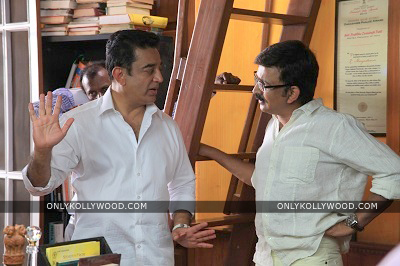 am. “Just because I’m the director,
am. “Just because I’m the director,
doesn’t mean I have the authority to do everything. I also think you need to be blessed with a good team. I could direct peacefully because I didn’t have to worry about music because there is Ghibran – Pinnraanpa andha paiyyan – and I know he will take care of it. I don’t have to sit with him every minute to see what he’s doing. Gauthami ma’am has done the costumes in Uttama Villain. With her on board, I don’t have to worry about costumes because I know they’ll come out well.”
Ramesh is aware of the fact that Bollywood is plagued by the Rs 100 crore box-office clubs. But, what’s important to him is the producers should recover his cost. “The Rs. 100 cr club box-office business is a different ball game. It will still take southern cinema a while to get there. The recovery of initial investment in a project is critical. If the film makes more money, it’s an added bonus,” says Ramesh.
As we plan to conclude the interview, we ask Ramesh the most important question, “When can we expect Uttama Villain to come out”.
 With a loud laugh, he says “There’s lot of VFX work in the film. We are currently working on it. I’m hoping it should be out in about ten weeks from now”.
With a loud laugh, he says “There’s lot of VFX work in the film. We are currently working on it. I’m hoping it should be out in about ten weeks from now”.
Once Uttama Villain was wrapped up, Ramesh Aravind sent a text message to his crew, and it read: “Thanks guys for working on the film. We’ve made a film we can all be proud of and I’m confident about it”.

